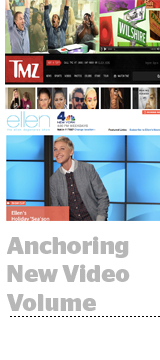 Warner Brothers is moving deeper into programmatic video, using Tremor Video’s supply-side platform exclusively to set brand controls around certain properties and to help monetize more mobile video inventory.
Warner Brothers is moving deeper into programmatic video, using Tremor Video’s supply-side platform exclusively to set brand controls around certain properties and to help monetize more mobile video inventory.
The move to adopt an SSP, which it first began testing in Q2 of last year, is in lockstep with Warner Brothers CEO Kevin Tsujihara’s prediction during parent Time Warner’s Q1 earnings call that, in digital, programmatic “could lead to millions of dollars of savings through efficiencies on the digital marketing side.”
While the entertainment giant already has an abundance of online video content across its portfolio of properties, including movie review site Rotten Tomatoes, celeb gossip show and publication TMZ and the site Ellen (which reportedly has more online video views than BuzzFeed), Warner Brothers sees more opportunity for video monetization.
TMZ, for instance, serves between 1-2 billion display ad impressions per month using Google’s AdX and Rubicon Project, according to Joe Catanzaro, VP of digital ad operations and strategy for Warner Brothers.
The question is how to leverage that massive reach in video.
“We’re focused on getting the right partners in place, so that for every impression that’s served, we’re maximizing value on that,” Catanzaro said. “We’re working on facilitating deals with [many direct clients] programmatically, whether that comes to us through a DSP, agency trading desk or through conversations we have internally with the client.”
Certainly there are opportunities today to serve formats like a home-page roadblock or full-page skin programmatically. But that doesn’t discount the level of customization needed for high-touch sponsorships and integrations afforded by personalities like TMZ’s Harvey Levin and Ellen DeGeneres.
There are also contextual considerations. For example, the bulk of Rotten Tomatoes’ inventory is ads that run before movie trailers. But ad formats on other sites include more custom content and celebrity interviews.
Warner Brothers is experimenting with its SSP to ensure it meets brand controls and compliance standards.
For example, if Justin Bieber performs on “The Ellen DeGeneres Show,” it’s not uncommon for a record label to place restrictions on any incremental monetization of that song or performance. In a case like this, Warner Brothers might use Tremor to meet such rules or restrictions on content cleared for advertising.
It’s important for broadcasters to increase yield, but the reality is the broadcast environment is laced with complexity.
Warner Brothers produces content but, unlike a company like Comcast, doesn’t own a cable distribution channel like NBCUniversal. Consequently, it often sells shows on a first-run syndication basis – meaning it sells the rights for shows to air on local stations, before hitting big geographic markets like New York or Los Angeles. This process complicates ad sales rules.
For instance, the WB may split syndication rights with a cable company or a local multichannel video programming distributor, while WNBC – the New York flagship station for the broader NBC Television Network – takes remaining ownership over sales.
“One of the benefits of Tremor is it allows us to carve out additional demand and to be really above the board with clients and allow them to make the decision of whether they want to run an ad or not,” Catanzaro said.
In addition to piping up for programmatic, Warner Brothers is planning more support for mobile video, given eMarketer’s prediction that mobile video spend will practically double in the US from $2.7 billion in 2015 to $4 billion in 2016.
“Mobile video is where a good portion of consumption comes from across our site, whether that’s on mobile web or on app,” Cantanzaro said. “From a sales perspective, we’re looking at this as video everywhere. When we do pitch it, we pitch it as a package,” though Warner Brothers is testing different formats for different devices.
Some advertisers want to run specific creative on iOS or Android, or set different parameters for campaigns, where “maybe they’re OK with a 30-second video on desktop,” he added, but on mobile, “we want it to be much shorter-form because the user experience is so different.”













